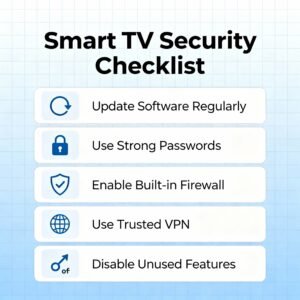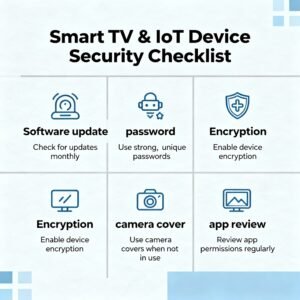Can Your Smart TV Be Hacked? Network Security for IoT Devices
Introduction
In modern homes, the smart TV is often the centerpiece of entertainment. It connects to Wi-Fi, streams content from multiple apps, syncs with mobile devices, and even supports voice assistants. While this connects us to a world of convenience, it also raises an important question: can your smart TV be hacked?

The answer is yes. Just like smartphones, laptops, and desktops, smart TVs are also susceptible to cyberattacks. Because they are part of the growing Internet of Things (IoT) ecosystem, they can become targets for hackers looking to exploit weak points in home networks.
In this blog, we will explore how smart TVs can be hacked, the risks involved, and how to strengthen network security for IoT devices. We’ll also discuss practical strategies you can use to protect your smart TV and other connected devices.
Understanding Smart TVs as IoT Devices
Smart TVs fall under the category of IoT devices because they connect to the internet and interact with other systems. These televisions often include apps, voice assistants, Bluetooth functions, and cameras. Unlike traditional TVs, they operate like mini-computers, which means they inherit both the advantages and vulnerabilities of connected devices.
IoT devices are often designed with functionality in mind but not always with top-level security. Since the average consumer doesn’t update the firmware regularly or apply strong security settings, hackers find smart TVs a tempting entry point into home networks.

Reasons Smart TVs Are Vulnerable:
-
They are always connected to Wi-Fi or LAN.
-
Manufacturers may not roll out frequent security updates.
-
Users often ignore firmware updates.
-
They include built-in apps that may collect data or be exploited.
-
Integration with microphones and cameras adds privacy concerns.
Can Your Smart TV Actually Be Hacked?
Yes. Cybersecurity researchers and real-world cases prove the possibility of smart TV hacking. Several incidents over the last decade have shown vulnerabilities that attackers can exploit.
Examples of how smart TVs can be hacked:
-
Exploiting outdated firmware – Hackers can use unpatched security flaws to access the TV operating system.
-
Malicious apps – Some apps installed from unofficial sources may plant malware.
-
Network hijacking – Attackers connected to the same Wi-Fi network may gain access to the TV.
-
Microphone and camera misuse – TVs with built-in cameras/microphones can be remotely activated.
-
DNS hijacking – Hackers can redirect traffic coming from the smart TV to fake websites.
Real-World Example
In 2019, it was reported that hackers could take over Samsung smart TVs using older firmware versions. Similarly, various manufacturers have had to patch vulnerabilities that allowed remote control of television functions.

Risks of a Hacked Smart TV
If your smart TV is hacked, the consequences can go beyond inconvenience. For most people, the idea of a hacker turning up the volume or changing channels seems harmless—but the risks are much deeper.
Risks Include:
-
Privacy invasion: Hackers may use microphones and cameras to spy.
-
Data theft: Stored account information (streaming services, login credentials) can be stolen.
-
Entry into your network: Smart TVs are often the weakest link, giving hackers a path to other devices on the same Wi-Fi.
-
Ransom attacks: Cybercriminals could lock your smart TV and demand payment for reactivation.
-
Spread of malware: A hacked TV could be used as part of a botnet to launch larger cyberattacks.

How Hackers Target Smart TVs
To understand how to secure your devices, you need to know the methods attackers use. Here are the most common techniques:
-
Phishing and malicious links – Clicking suspicious ads or downloading unverified apps on the TV.
-
Weak passwords – Default credentials make it easy for attackers to break in.
-
Unsecured Wi-Fi networks – Hackers nearby can intercept data packets.
-
Firmware vulnerabilities – Old system software leaves the TV exposed.
-
IoT botnets – Hackers use automated tools to scan for vulnerable devices connected to the internet.

Strengthening Network Security for IoT Devices
If smart TVs and IoT devices are here to stay, protecting them should be a top priority. Security doesn’t stop at installing antivirus software; it requires a layered approach from network setup to device configuration.
Key Protective Measures for Smart TVs and IoT Devices
-
Keep firmware updated – Regularly check for updates in your TV settings.
-
Disable unused features – Turn off cameras, microphones, or Bluetooth if not needed.
-
Use strong Wi-Fi passwords – Replace default router credentials with unique passphrases.
-
Enable firewall settings on your router – This helps detect unusual traffic patterns.
-
Segment your network – Use a separate guest network for IoT devices.
-
Install apps only from official sources – Avoid unofficial APKs or sideloaded apps.
-
Regularly restart and scan devices – Some attacks are temporary and flushed out by reboots.
-
Use VPNs when possible – Protects data from interception.

Future of Smart TV Security

As IoT devices grow in number, manufacturers are under pressure to embed stronger security. The future may bring:
-
Automated security updates directly pushed by manufacturers.
-
AI-driven monitoring systems to detect anomalies.
-
Built-in encryption for user data.
-
Stricter app vetting and permissions.
Consumers, however, must remain vigilant. While better technology can help, the ultimate responsibility is shared between manufacturers and users.
Practical Checklist for Home Users
If you want a quick action plan to safeguard your smart TV and IoT devices, follow this checklist:
-
Update your smart TV software monthly.
-
Change router default login credentials immediately.
-
Create separate networks for personal devices and IoT devices.
-
Use strong WPA3 Wi-Fi encryption.
-
Cover your smart TV’s camera when not in use.
-
Avoid storing sensitive credentials in the smart TV.
-
Regularly review installed apps and remove unnecessary ones.

Conclusion
So, can your smart TV be hacked? Absolutely. Smart TVs, like all IoT devices, bring convenience but also risk. Cybercriminals can exploit outdated firmware, insecure networks, and weak passwords to gain access. From spying via microphones to infiltrating your home Wi-Fi, a hacked television is more than a nuisance—it’s a serious vulnerability.
The good news is that protecting your devices doesn’t demand advanced technical skills. Updating firmware, configuring routers securely, and practicing safe app usage go a long way. As IoT evolves, security will become stronger, but users will always need to stay proactive. Remember, your smart TV isn’t just a screen; it’s a computer on your wall. Treat it with the same caution you give your laptop or smartphone.